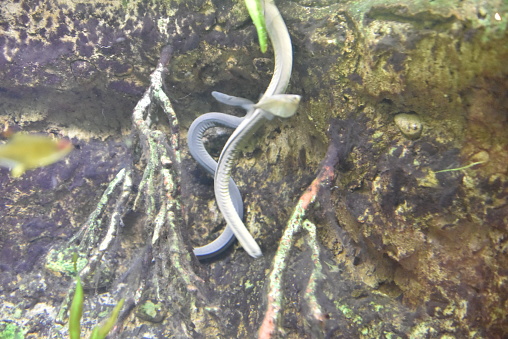ANIMAL: Rio Cauca Caecilian Typhlonectes natans Type of Animal: Caecilian Habitat: Rivers, marshes, lakes, shallow streams, floodplains, polluted water, tropical/subtropical moist shrubland, tropical/subtropical dry shrubland, tropical/subtropical seasonally wet/flooded lowland grassland, dry savanna Location(s): Colombia, Venezuela, possibly Trinidad & Tobago Appearance: Elongated limbless dark gray to black to dark purplish/bluish-gray amphibian w/ paler ventral surface, looks like aquatic snake/eel (but not reptile or fish), lateral flattened body gives segmented appearance (not segmented worm either) Food/Diet: Worms, insects, insect larvae/eggs, spiders, shrimp, fish, carrion Status in Wild: Stable Conservation: Breeding in zoos, aquariums, herpetoculture, & aquaculture Lifestyle: Small groups of around 4 individuals Additional Info: Called: Male Female Young: Larva Group: Colony Weight: Male: 1.34 oz Female: 1.8-6.07 oz Gestation: 6-7 months Life Span: 5 years in wild, 10-13 years in captivity Body Length: Male: 0.82-1.91 ft Female: 0.94-2.37 ft Young: 0.5 ft Main predators are pigs, birds, fish, & snakes. Unlike many amphibians, they’re ovoviviparous, w/ eggs developing inside mom’s body, coming out as live young. Usually 1-11 live young born. Fetuses develop large gills which drop off a few hours after birth. Sexually mature at 1 year old. Like most amphibians, they breathe through skin, though they sometimes breathe at surface. Left lung smaller than right lung. Tentacles on head help them find food/sense predators/feel surroundings. Mating involves male inserting penis-like organ (phallodeum) into female cloaca for 2-3 hours. Since they’re basically blind, they hunt using smell. Hearing also quite poor. They’re very secretive in the wild. Peg-like teeth used to grip/tear prey. Spend entire lives in water, being able to thrive in polluted water as well as dried up water. Adults can hold breath for 30 minutes at a time. They often wait patiently for prey. Fun Fact(s): Females have been found to double weight before giving birth. Name Caecilian comes from Latin word “caecus” meaning blind, since eyes tiny & they’re basically blind. While basically being blind, they can tell difference between light & dark. Often called rubber eels due to appearance. High tolerance for polluted water key reason why they’re doing well in wild. Sometimes kept as pets & due to eel-like appearance/aquatic habits, sometimes sold as fish.
